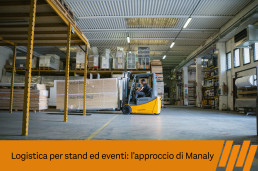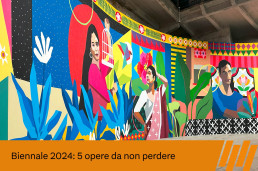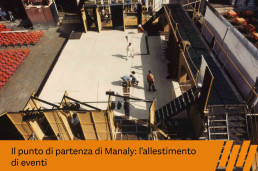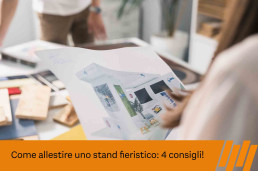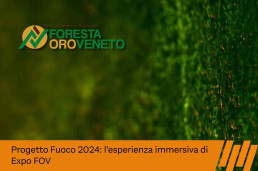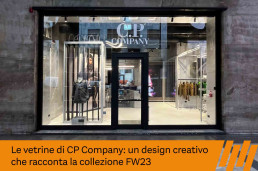Logistics for stands and events: Manaly's approach
In the field of trade show and event setup, logistics play a key role in creating quality displays. Stands and events undoubtedly represent great opportunities for branding and growth for companies, but they are often challenging in terms of management and transportation.
In the following paragraphs, we will explain how we at Manaly handle logistics for stands and events, also striving to optimize costs, movements, and productivity flows. Keep reading the article!
Logistics for stands and events: the importance of planning
When it comes to logistics for trade show stands and events, three concepts emerge as fundamental: flexibility, dynamism, and above all, planning. These principles guide every phase of our work at Manaly and are particularly important when working with customized projects. For us, every job is a unique project that requires tailored management.
The logistics process for trade show stands and events begins with careful and thorough planning. This preliminary phase is crucial to organizing movements and transportation in the best possible way. From these early stages, it is necessary to adopt a flexible mindset that is open to unforeseen circumstances, to be ready to respond quickly and with concrete solutions to any obstacles that may arise.
Through discussions with the heads of various departments, priorities are established based on deadlines, production times, and staff availability. At the same time, the operational site plan is developed, which includes the logistical planning of vehicles and personnel, travel arrangements, hotel bookings, flights, and other organizational aspects.
Accurate planning and effective preparation ensure that those working on-site, in the field, can operate in the best conditions. Our planning, therefore, cannot follow a rigid industrial model but must be dynamic and flexible in its operational details.
Do you want to learn about all the other stages necessary for creating a stand in detail? Find out by clicking here!
The warehouse: a strategic ally for successful stands
The warehouse plays a central role in our logistics strategy for stands and events. It is not just a storage space but an operational center that significantly contributes to the effective management of projects. In a sector where stands often need to be transported between different cities, countries, or trade shows, an efficient warehouse becomes a key resource.
Having a warehouse available offers several benefits. Let's look at some of them together!
- Cost and movement reduction: storing materials in a single centralized location helps reduce transportation expenses and minimize unnecessary movements.
- More efficient planning: having a single reference point for storage helps in planning and generally in managing projects and orders.
- Material preservation: the warehouse allows for the safe and optimal storage of equipment and materials needed for assembly. It also serves as a storage area for stands; at the client's request, here at Manaly, we can store the stand in our warehouse.
The future of logistics for stands and events at Manaly: innovation and development
All departments of Manaly, including the logistics area, are at the center of an innovation process aimed at making management increasingly "lean," that is, more efficient and functional. This improvement journey is already underway and continues to evolve, starting with the training courses we are undertaking with Gianesin, Canepari & Partners.
This commitment to training allows us to continuously improve our processes and guarantee high-quality service at all stages of the job.
Did you find this article on logistics for stands and events useful? If you are interested in creating a trade show stand or event, know that we will support you from start to finish with your project. Don't hesitate to contact us!
Restart in the Trade Show Sector: Our Upcoming Events
With the end of the summer break, September marks the full resumption of activities in the trade show sector. Before moving forward to the upcoming fairs and events in 2024, it’s essential to take a moment to reflect on the successes achieved by Manaly, carefully plan new goals, and discover the events that await us.
Continue reading the article to discover the latest updates in the trade show sector!
Manaly: What Milestones Have We Achieved?
In recent months, Manaly has worked intensively to promote business growth and professional development within the team.
- Revenue Increase: We are proud to have recorded a 15% increase compared to August 2023. This result reflects our continuous commitment to improving our processes and services in the trade show sector.
- Sustainability: We have invested in sustainability training, starting to calculate our environmental impact and focusing on waste and scrap materials. We are working to integrate recycling practices and reusable products into our production processes, involving all departments in this green journey. If you're interested in learning more about sustainability, click here!
- Personal Growth and Business Efficiency: Among various operations, the purchase of new machinery and the new layout of the workshop will allow us to optimize workflows, reduce waste, and improve space management. In the logistics department, we are also pursuing the goal of optimizing business processes and implementing more streamlined and efficient management.
These initiatives aim to bring concrete improvements, both qualitative and quantitative, in the management of the company and the creation of value for our customers.
Upcoming Trade Show Events: What’s Ahead?
Looking to the future, Manaly is ready for a series of unmissable moments in the trade show sector.
Among the most important fairs, Lineapelle Milano, the international reference for the leather and accessories sectors, and Vicenzaoro, stand out, where Manaly will set up the west square, the entrance to the fair, with the seven monoliths for the 70th anniversary of the event. To find out more, read our case study by clicking here!
Other events to mark include TFWA Cannes (duty-free and travel retail), CPHI Milano (pharmaceutical market), Sial Paris (food industry), BIMU (mechanical/industrial), EIMA (agriculture and gardening), Medica (medical sector), and SPS Nuremberg (automation).
Regarding events, Manaly will play a leading role in the realization of several significant ones. Let’s take a look together!
- The exhibition “Illustri, Saranno Illustri, Maestri Illustri” part of the Illustri Festival, regularly transforms iconic locations in Vicenza, such as the Basilica Palladiana, into vibrant art scenes. Manaly is proud to collaborate once again on this initiative. To see what we created in the previous edition, you can click here!
- The exhibition for the 250th anniversary of the Guardia di Finanza, which will be hosted at Palazzo Madama in Turin. After the success of the previous edition held at the Vittoriano in Rome, Manaly renews its collaboration with the Guardia di Finanza. You can read all the details about the exhibition by clicking here!
- The Caseus event, founded in 2005 to celebrate the skill and passion of Italian cheese producers. On this occasion, too, Manaly will be involved in the organization, overseeing the design and setup of the Veneto Agricoltura booth and its subsidiaries. Want to learn more about the event's history? Take a look by clicking here.
For Manaly, an intense period full of challenges and significant moments lies ahead. We are ready to face the upcoming trade show events and the next events with the same professionalism and attention that have always set us apart.
Did you find this article on the revival of the trade show sector helpful? If you're interested in creating a trade show booth or event or if you need information on this topic, Manaly is at your disposal—contact us!
Biennale 2024: 5 Must-See Works
A few days ago, the Manaly team visited the 2024 Biennale Arte to discover the most astonishing works. Join us on this artistic journey and read on to find out the five pieces that impressed us the most!
The 2024 Biennale Arte: "Foreigners Everywhere"
Curated by Adriano Pedrosa, this year's edition explores the theme of the "foreigner" in all its facets. Venice transforms into a cultural crossroads, hosting a grand international exhibition in the Giardini and Arsenale, enriched by numerous national pavilions and a rich collateral program of exhibitions, projects, and performances. Don't miss the opportunity to visit it until November 24, 2024. If you want to learn more about the history of the Biennale, click here!
The 5 Works at the 2024 Biennale Arte That Captivated Us
- Yinka Shonibare: A Nomadic Astronaut Right at the entrance, we were greeted by the incredible work of Yinka Shonibare, a world-renowned British-Nigerian artist. His series "Refugee Astronaut" features a life-sized astronaut adorned with "African" fabrics, loaded with symbolism. This figure speaks to us about the challenges of displacement, the ecological crisis, and environmental neglect, questioning the unsustainable pursuit of perpetual growth and colonial connotations.
- Mataaho Collective: Weaving Life A little further along, we immersed ourselves in the work of the Mataaho Collective, formed by four Māori women artists. Their installation "Takapau," observable from multiple perspectives, draws inspiration from the traditional ceremonial mat. However, it weaves carefully selected materials to create a complex structure. The magic of lights and shadows on the woven patterns provided us with a unique visual and sensory experience.
- Naminapu Maymuru-White: Rivers of Stars The art of Naminapu Maymuru-White, a Yolŋu Elder, transported us to the heart of the night sky. Her bark paintings, with twisting and turning rivers of stars, offer an immersive view of the Milky Way and the Milŋiyawuy river. Each star represents past, present, and future souls, intertwining the physical and ancestral worlds in a multidimensional work.
- Dana Awartani: Healing the Wounds Dana Awartani's installation, Come, let me heal your wounds. Let me mend your broken bones (2024), is a powerful requiem for the destroyed historical and cultural sites in the Arab world. Each tear in the silk fabric marks a devastated site, carefully mended to symbolize the scars of the real world. The use of natural dyes from herbs and spices adds another layer of meaning, connected to the sacred healing properties of Kerala's textile traditions.
- Aravani Art Project: Explosion of Colors The work of the Aravani Art Project, a collective of cis and transgender women, impressed us with its explosion of colors. The mural commissioned for the Biennale explores the experiences of trans bodies and nature, challenging dominant norms and offering a narrative of hope and acceptance. The vibrant colors, inspired by Indian tradition and LGBTQ+ and trans flags, transported us to a world of diversity and inclusion.
Manaly at the Icelandic Pavilion
This year, Manaly is not just a collaborator but an integral part of the Iceland Pavilion's work. Artist Birgisdóttir invites visitors to reflect on our connection to objects through a multisensory experience. For this installation, she asked us to provide a branded chair and table, evoking the theme of mass production criticized by the artist. Learn more in our dedicated article, click here.
If you have a project or idea you want to realize, remember that Manaly is the creative partner you can count on. Don't hesitate to contact us! In the meantime, you can check out our previous projects, click here!
The starting point of Manaly: event setup
Event setup is an activity that combines creativity, organization, and precision. Every event, whether it is a fair, a conference, a festival, or a ceremony, requires careful planning that considers not only the aesthetic aspect but also the functionality and safety of the spaces. With 40 years of experience in the industry, Manaly has made event management the real turning point in its history. Continue reading the article to learn more!
The History of Manaly: From Origins to Success
The story of Manaly begins in 1981 when a group of 12 enterprising young men decided to found a cooperative with a name that represented the spirit of their initiative: Manovali Nati Liberi, today known as Manaly. The goal was clear: to work with passion, aiming for professional and personal well-being and growth. In the early years, Manaly focused on renovation, restoration, building and green area maintenance, and general porter services. These activities laid the foundation for a versatile and reliable cooperative called Manaly Services.
The turning point came in 1984 when Manaly won the contract for the setup of the Mozart Festival in Vicenza, the city's most prestigious event. This assignment marked the beginning of specialization in event setup, expanding services to the theatrical and fair sectors. Since 1989, Manaly began to focus on trade show exhibitions, gradually reducing the original activities. This evolution led to the creation of Manaly Stand Events, eventually becoming today's Manaly Design&Build, a reference point in the event setup and trade show design sector.
Curious to learn more? Through the historical archive of Manaly, you can immerse yourself in the highlights that have defined our journey. Click here to browse it!
The Art of Event Setup: Synergy Between Aesthetics and Functionality
The process for event setup begins with planning, where the event's objectives and the client's needs are defined. Next comes the design phase, in which detailed layouts, scenographies, and decorations are created. Logistics play a crucial role: coordinating setup and dismantling times, managing suppliers, and ensuring everything is perfectly in order requires experience and competence.
A successful setup is one that amazes the participants, creating an environment that fully reflects the desired theme and atmosphere, without neglecting comfort and safety. Event setup is therefore a combination of aesthetics and functionality, where every detail counts to transform a vision into reality.
Click here to learn more about how Manaly manages event setups!
Innovation and Sustainability: The Future of Event Setup
Event setup is continuously evolving, with increasing attention to innovation and sustainability. Advanced technologies are revolutionizing the way events are conceived and experienced, improving participants' experience and optimizing design and setup processes. At the same time, sustainability has become a fundamental pillar. The use of recyclable materials, the implementation of eco-friendly practices, and waste reduction are now essential for companies in the sector.
A concrete example is the event that Manaly set up for Inditex, developed in Zara's flagship store during the Fuorisalone in Milan. In this project, the structure had to be built with sustainable and fully recyclable fabrics, in line with Inditex's "zero waste" approach. The structure transformed the store's entrance into a sensory pathway, harmonizing with the brand's heritage and dialoguing with the original architecture. Take a look by clicking here!
If you need to set up or organize a corporate event or want to design your trade show stand, you can rely on us at Manaly. For over 40 years, we have been supporting companies in identifying the best expression solution. Contact us and find out if we are right for you!
Manaly: Sustainability as a Growth Engine
Manaly has always stood out for its commitment to environmental sustainability. Our company, with a strong focus on eco-friendly practices, already boasts certifications such as PEFC and Legno Veneto, confirming our active membership in the Consorzio del Legno Veneto. However, our goal is to take a further step forward to obtain new certifications and constantly improve our sustainable practices. To achieve this goal, we are investing in a series of training courses and consultations aimed at deepening our knowledge in the green sector.
Sustainability is also a matter of... training
In recent months, we have undertaken an intense and thorough training path, structured around various fundamental themes for our sustainable growth. The first courses focused on exploring wood, delving into its applications in the sectors of setup, furniture, and construction. This allowed us to gain a comprehensive overview of the potential and peculiarities of this material. We also examined products and practices related to the circular economy, studying the reuse of materials and waste minimization. These courses represent only the beginning of a long training journey that will last months.
In this context (project “Wood Green & 4.0 Transition in the Veneto Wood Sector”), we were accompanied by the Consorzio del Legno Veneto, along with Andrea Zenari, Gilberto Toneguzzi e Enrico Cancino.
Measure to improve: calculating our environmental impact
The next step in our training path, with the support of Gianesin, Canepari & Partners, will focus on calculating our environmental impact. Understanding and measuring the impact of our activities is essential to implement effective emission reduction strategies and improve our company's overall sustainability. We will involve every department, from production processes to logistics, to ensure that everyone has the awareness and skills necessary to contribute to our common goal of reducing environmental impact.
We want Manaly's commitment to sustainability to materialize in tangible and continuous actions. Investing in employee training and calculating our environmental impact is just the beginning of a journey that will make us increasingly ecologically responsible.
We are convinced that aiming for a more sustainable future is not only a duty to our planet but also an opportunity to innovate and constantly improve. Sustainability is a choice that pays off, and we at Manaly are ready to do our part for a greener tomorrow.
Sustainability in action: our success stories
Our commitment to sustainability is reflected in the projects we carry out. The Ferretto stand is a prime example, featuring a back wall entirely made of PEFC-certified material, demonstrating how the use of sustainable materials can seamlessly integrate into exhibit design. Click here to learn more!
Another significant project is the Veneto Agricoltura stand, where the wood used for the construction of the huts is PEFC and Legno Veneto certified, coming from sustainably managed forests in the Veneto Region. Take a look by clicking here!
In the Caffè Diemme stand, we also used raw wood boards recovered from the Vaia storm damage, highlighting our commitment to reusing natural materials. To find out more, click here!
These projects are tangible testimonies of our commitment to promoting responsible resource management and actively contributing to environmental conservation.
Did you enjoy this article on corporate sustainability? If you are interested in creating an exhibition stand or need information on this topic, Manaly is at your disposal. contact us!
Venice Biennale 2024: Manaly's role at the Iceland Pavilion
The 60th International Art Exhibition - La Biennale di Venezia 2024 opened its doors to the public a few weeks ago, presenting an engaging and provocative artistic experience. This year, Manaly's participation is not merely as an exhibitor but as an integral part of the work featured at the Iceland Pavilion. Keep reading the article to find out more!
La Biennale di Venezia 2024: Stranieri Ovunque – Foreigners Everywhere
The theme of this edition, "Stranieri Ovunque – Foreigners Everywhere," traces an evocative trajectory outlined by curator Adriano Pedrosa: "Wherever you go there are foreigners and immigrants, but at the same time wherever you go you are always a foreigner." This title draws inspiration from the works of the Claire Fontaine collective, which since 2004 has been creating neon sculptures with the expression "Stranieri ovunque" in various languages, originally proposed by the name of a Turin collective from the 2000s engaged in the fight against racism and xenophobia in Italy.
La Biennale di Venezia 2024 highlights immigrant, diasporic, exiled, or refugee artists, along with those who belong to queer communities: 331 artists and collectives from over 80 countries. This edition stands out for its clarity, essentiality, and absence of surprises, contrary to the expectations of some.
Among the many works and installations animating the exhibition spaces, the Iceland Pavilion stands out presenting "That’s a Very Large Number - A Commerzbau" by Hildigunnur Birgisdóttir, curated by Dan Byers. The work explores the complex relationships between us and the world of mass-produced objects.
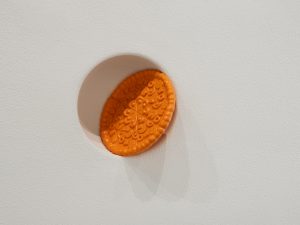
The Artist and Critique of Global Systems
Hildigunnur Birgisdóttir, a visual artist from Reykjavik, pursues a nuanced artistic practice focused on critiquing global systems of production and distribution. Her work focuses on the peculiar lives of the objects that populate our daily lives, often overlooked or considered disposable accessories of material culture. By using systems and human interactions as integral parts of her artistic process, Birgisdóttir creates works that draw attention to the objects that exist at the margins of our vision.
The Iceland Pavilion in Venice: A Dialogue with Objects
Inside the Iceland Pavilion at the Biennale di Venezia 2024, visitors are greeted by an immersive environment reminiscent of Kurt Schwitters' "Merzbau." The walls, painted in faded white, are composed of old light switches and plastic electrical cables, creating a suggestive frame for the exhibited works.
A vast wall installation, made with recycled materials from the Biennale di Venezia 2023, is adorned with the logos of companies and suppliers that contributed to the creation of the pavilion (including Barbie, Google, DHL, Sutton, Iceland Air, Manaly, and others). Through sculptures and installations exploring object relations, Birgisdóttir offers visitors a multisensory experience that invites reflection on our connection with objects.

For example, small plastic toys, originally intended for dollhouses, have been digitized, enlarged, and replicated. The sculptures capture the extraordinarily smooth surfaces and simplified forms of the toys, designed to convey only the essential information to understand their function. One sculpture was created using recycled jute coffee sacks, while another was made with recycled denim, both modeled on the shapes of small economical packages that protect the products we intend to purchase.
Manaly's contribution to the Biennale di Venezia 2024 concerns the chair and table placed at the center of the area, branded and wrapped with our logo in series, evoking the concept of mass production, a theme the artist critiques. Birgisdóttir's work reflects the tension between the personal pleasure we can find in our world of material objects and the consequences of an excessive invasion of such objects in our daily lives.
This year, Manaly had a different role than usual: we weren't just exhibitors, but an integral part of the project. It was a truly stimulating experience for us!
In the past, we curated the setup of the Chile Pavilion at the Biennale di Venezia. If you want to take a look at our previous work, you can do so by clicking here.
If you also have a project or idea you want to realize, keep in mind that Manaly is the creative partner you can count on. Feel free to contact us! In the meantime, you can take a look at our previous achievements, click here!
From concept to the setup of exhibition spaces
Within the realm of commercial spaces and events setup, creating a project and furnishings that fully reflect the brand's identity can seem like a daunting and complex task. Finding a tailor-made solution without facing technical or logistical obstacles can often become a challenging endeavor. However, there is an effective answer to this need: choosing an exhibitor that accompanies you from the beginning to the end of your project. In this article, we'll guide you through how this service works, what it entails, and whether it truly represents the ideal solution for your needs. Keep reading to find out more!
Study, Design, and Implementation of Exhibition Stands
This service, called "turnkey," is offered by setup companies and includes all phases of the process, from conception to installation. This allows customers to fully rely on the company's team of experts, eliminating the need to coordinate multiple suppliers and manage various project phases. From the initial concept to practical realization, everything is handled in an integrated manner, ensuring high-quality results and greater peace of mind for the customer. A crucial phase of the turnkey design process is planning and preliminary analysis. Before starting the project, fully understanding the client's needs and expectations is essential. This involves a careful evaluation of spatial requirements, budget, and marketing objectives. Once this information is acquired, the design team can develop a tailor-made concept that meets all the specified requirements. This service caters to all types of exhibition spaces: stands, events, showrooms, retail, and exhibitions/museums, offering numerous benefits to the customer.
From Concept to Setup: The Advantages
The advantages of choosing a single partner are manifold. Let's explore them together!
- Time and Resource Savings: The customer no longer needs to spend time searching for and coordinating suppliers, allowing for greater focus on their core business.
- Quality and Creativity: Thanks to the experience and expertise of the setup team, the results are characterized by innovative and functional design.
- Flexibility: The service adapts to the specific needs of the customer, allowing for changes during the process without compromising the quality of work.
- Customization: With the support of a dedicated team, the company turns ideas into reality, creating exhibition spaces that reflect the brand's goals, identity, and values.
How Much Does an Exhibition Stand Cost?
The cost of an exhibition stand can vary significantly, depending on various factors such as its size and the client's specific requirements. The material, integrated technologies, and other details also impact the final price. The location and duration of the event are important, as they influence logistical and transportation costs. Considering these factors, it's essential to establish the budget during the initial phase in order to create a tailor-made project.
After 40 years of experience in the industry, we at Manaly are convinced that entrusting the entire design and setup process to a single company ensures peace of mind and maximum efficiency.
Did you find the article on the study, design, and implementation of exhibition stands or other types of exhibition spaces useful? If you'd like to explore our projects, we invite you to visit our "Gallery" page or, on the "Case Study" page, you can discover our success stories!
If you want to turn your vision into reality, Manaly is the reliable partner you can count on, contact us!
How to set up a trade show: 4 advices!
In the competitive landscape of trade shows, designing a booth is no longer simply a matter of displaying products or services. It has become a crucial component for capturing audience attention and effectively communicating the brand's distinctive values. In this context, the role of trade show professionals becomes fundamental to ensuring the company's success in the trade show arena. So, how do you set up a trade show booth in the best way possible? Keep reading and discover our 4 tips.
Aesthetics and visual appeal in booth setup
One of the primary aspects that distinguish a successful trade show booth is its ability to attract and capture visitors' attention from the first glance. Captivating design, intelligent space layout, and skillful use of colors and lighting are all crucial elements to create a lasting visual impact. Through consultation with professionals in the field of design, a booth can transform from a simple exhibitor to a creative work that reflects the essence of the brand. An interesting case is the Euronda booth at IDS!
Functionality and experience
In addition to aesthetics, a trade show booth must be functional and meet the needs of both exhibitors and visitors. Space layout should be intuitive, with well-defined areas for product presentation and optimized foot traffic to encourage interaction. In some cases, booths can be designed with particular functionality: being modular and adaptable for use in different trade shows. An example is the Stefanplast booth, which was created with the flexibility necessary to meet the various needs of different trade shows.
Furthermore, the integration of innovative technologies, such as interactive screens, virtual experiences, and product testing, not only adds a touch of modernity but also a level of engagement that can make a difference in the overall visitor experience.
Brand Identity in the trade show booth
An effective trade show booth is not only aesthetically pleasing and functional but also a tangible manifestation of the brand's values and identity. Every element, from graphics to materials used, should be carefully selected to reflect the company's history, mission, and personality. This consistency between the brand message and the appearance of the booth not only strengthens the brand's perception but also creates an emotional connection with the audience, fostering trust and customer loyalty. The Riyadh Airports booth is an example of this!
How to set up a trade show booth: the importance of design
Among the tips on how to set up a trade show booth, perhaps the most important concerns design. Without careful design, all other elements of a booth - from aesthetics to functionality - risk being compromised. It is essential to carefully consider the use of different areas and how they interact with each other to ensure good usability and readability for participants. Here are the main areas to consider to optimize the booth:
- Reception/welcome area;
- Meeting area;
- Storage area;
- Exhibition area;
- Relaxation/relationship area;
- Bar/catering area (if necessary).
In conclusion, designing a trade show booth goes beyond simply creating an exhibition space. It is a strategic opportunity to communicate, connect, and stand out. Relying on industry professionals is crucial to ensure that every aspect of the booth, from aesthetics to functionality, is optimized to maximize return on investment and leave an indelible impression on visitors. Therefore, it is essential that every booth is custom-designed, personalized to precisely meet the specific needs and goals of the company.
In this environment, Manaly stands out as the ideal partner: with 40 years of experience in the events industry, it provides a comprehensive service that includes all phases of planning and execution.
Was this article on how to set up a trade show booth helpful to you? If you are interested in creating a trade show booth or if you need information on this topic, Manaly is available, contact us!
Progetto Fuoco 2024: the immersive experience of Expo FOV
Highlighting RIR and the Consorzio Legno Veneto
Il Consorzio del Legno Veneto, belonging to the Regional Innovative Network (RIR), eagerly prepares for participation in the extraordinary Progetto Fuoco 2024 fair, taking place in Verona from February 28 to March 2, 2024. Expo FOV (Veneto Gold Forest) goes beyond the traditional trade show presence, aiming to create transparency, responsibility, and build lasting trust among current and future members. Communicating the value of participating companies, promoting the brand, and committing to entrepreneurial and environmental development define the objectives. The unique approach aims to promote cross-sector collaboration, stimulate research and innovation, address systemic issues, and raise awareness on crucial themes.
The Immersive Experience by Manaly
Manaly, an integral part of the Veneto Wood Consortium and RIR, is bringing this project to life. The distinctive feature is an immersive experience that transports participants into the heart of the Consortium and RIR. This experience will result from the collaboration between the companies of the Veneto Wood Consortium, each contributing with its own history, expertise, and products. The project aims to create a comprehensive experience that celebrates the diversity and excellence of the forest-wood sector in the region. Active participation underscores the collective commitment to promoting the supply chain and strengthening ties within the community.
Immersive Experience: Why Choose It?
The immersive experience is becoming increasingly central at trade shows. It offers visitors the opportunity to connect uniquely with companies and brands. This multisensory environment stimulates emotional interaction, leaving a lasting impression. Living the story and values of a company firsthand creates a deeper bond and fosters customer loyalty.
Immersive Experience: How to Make It Happen?
Creating a successful immersive experience goes beyond the mere implementation of advanced technologies. It requires careful planning, precise execution, and the presence of specialized skills. It is necessary to clearly define the objectives to be achieved and identify the target audience. These initial steps are crucial for creating a targeted and effective plan.
Choosing the right tools is equally crucial. With a wide range of technologies available, it is essential to understand the peculiarities of each.
However, a key element that cannot be overlooked is the choice of an experienced and competent partner. Collaborating with professionals in the immersive experience industry can provide valuable insights, offering advice on technical, creative, and strategic aspects. A competent partner can guide you in selecting the most appropriate tools, optimizing the creation process, and ensuring a smooth project realization.
Don't miss Expo FOV at Progetto Fuoco 2024: immerse yourself in a unique experience that celebrates and promotes sustainability and innovation in the forest-wood sector.
We look forward to seeing you from February 28 to March 2 in Verona!
If you are interested in the immersive experience, Manaly is available, contact us!
CP Company's Storefronts: A Creative Design That Tells the FW23 Collection's Story
For the Autumn/Winter 2023 season, CP Company's storefronts in Milan took center stage in their promotional campaign. The concept for this initiative was curated by Jordi Van Der Oord, the renowned creative director specializing in spatial and digital experiences for global brands, while its actual execution was entrusted to Manaly.
The project involved creating artistic installations behind CP Company's windows, inspired by the distinctive materials of the Autumn/Winter 2023 collection, with a creative and dynamic approach.
Continue reading the article to discover how we brought the four CP Company windows to life!
Toob - Inner Tube
TOOB is the abbreviation for Inner tube. On a base of colored cotton, a thin double layer of opaque polyurethane is layered. The slight interaction between these two layers gives an aged rubbery appearance, while the transparency of the outer coating on the seams completes the desired effect.
The first of the four CP Company windows was conceived based on this characteristic. Two structures with aluminum profiles were created, inside of which an inflation and deflation system of tubes was integrated. The combination of these components recreated the image of an inner tube, providing a dynamic backdrop for the clothing.
Micro M - Terrarium
Micro-M (R) represents the contemporary evolution of C.P. Company's iconic 50 Fili fabric. This innovation replaces traditional cotton yarn with a hydrophobic polyester microfiber and nylon with a specially recycled version.
The terrarium concept, realized inside the store, was directly inspired by the principle underlying Micro-M. The structure was designed around two mannequins showcasing the featured clothing, and natural elements such as soil, sand, and stabilized plants were introduced inside, aligning with the company's sustainability concept.
CP Program_3 - Carding
C.P. Program_3 constitutes the third chapter of C.P. Company's project, focusing on alternative production methodologies and the use of natural resources to minimize environmental impact in the clothing industry. This laboratory concentrates on waste elimination, promoting circular economy, employing research materials, and reducing the production chain.
The third installation fully embodies this concept. We devised an industrial plant with motor-driven rollers, gears, and chains. Traditional carding rollers worked the wool at the top and bottom of the structure, while in the heart of the installation, two rollers displayed a moving image, serving as a backdrop for the showcased garment.
DUFFEL & JAQUARD - Tapestry
C.P. Company's distinctive approach, merging technological innovation and aesthetic experimentation, is renewed by exploring the possibility of transferring Jacquard patterns to wool fabrics with the new Duffel coats.
This technique was implemented in both the traditional Montgomery style, characterized by refined toggle closures and a striped design, and in a more contemporary construction with a hood.
The last CP Company window featured the creation of a knitted tapestry inspired by the Duffel & Jacquard collection patterns, positioned as a backdrop for the clothing. Over time, the tapestry was designed to unravel. For this, a lower "thread winder" was designed to pull and gather the thread until complete unraveling.
Did you enjoy the realization of CP Company's windows? If you are interested in temporary installations, Manaly is at your disposal, contact us!
